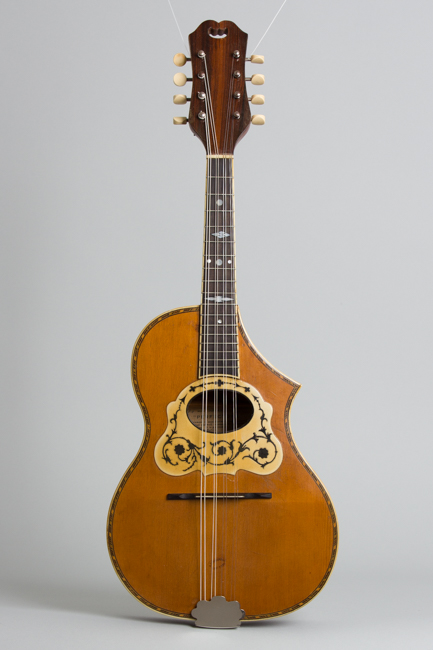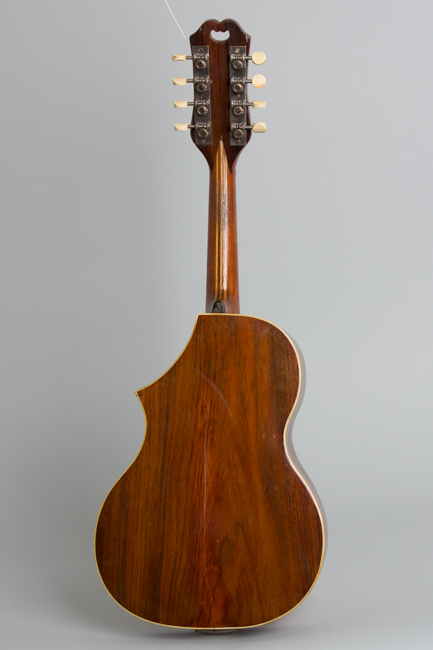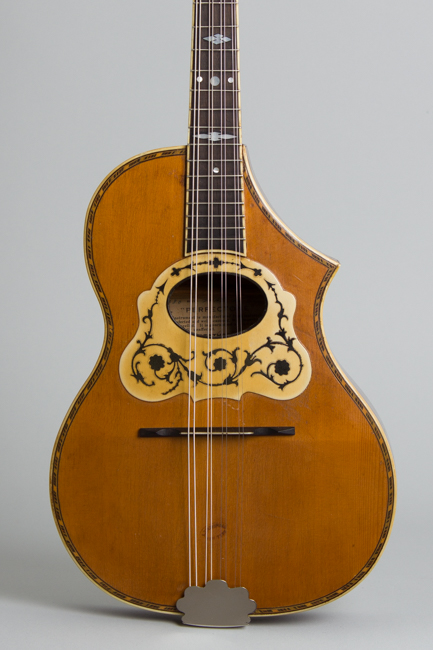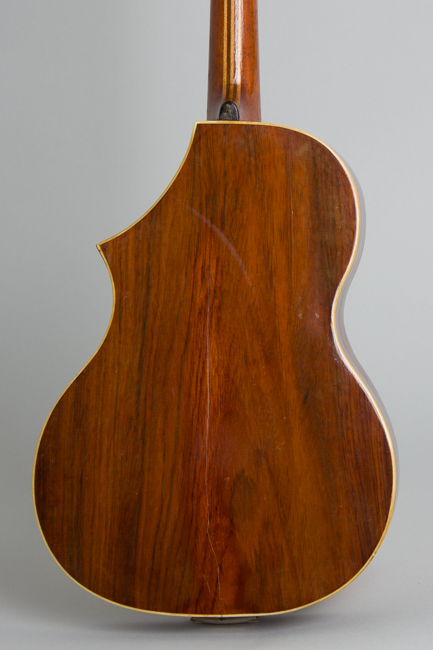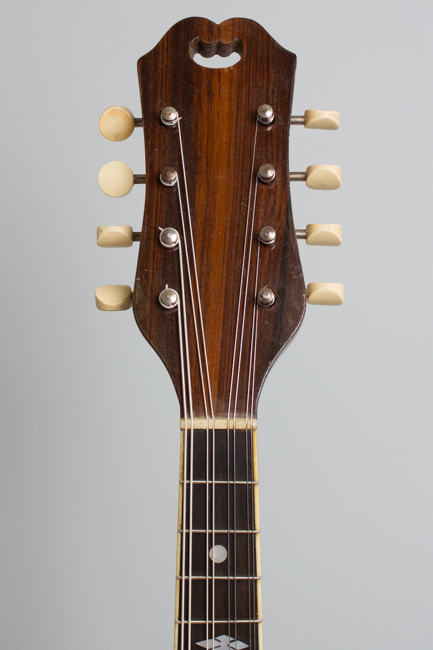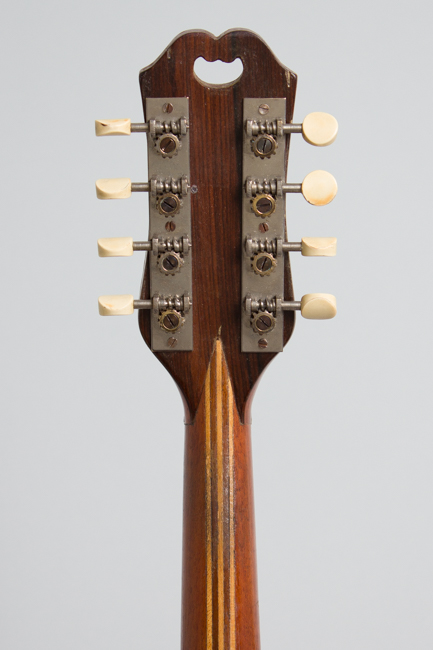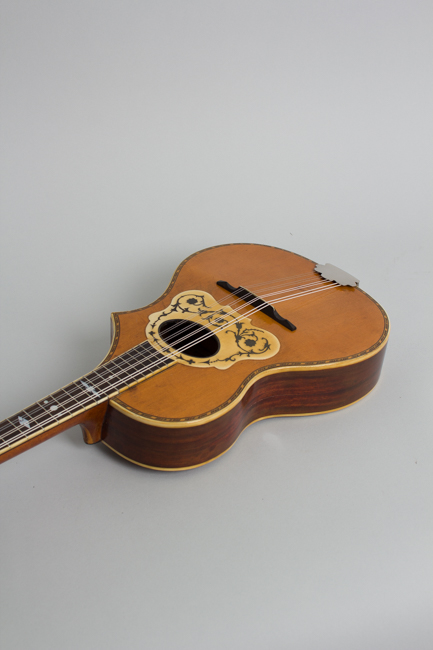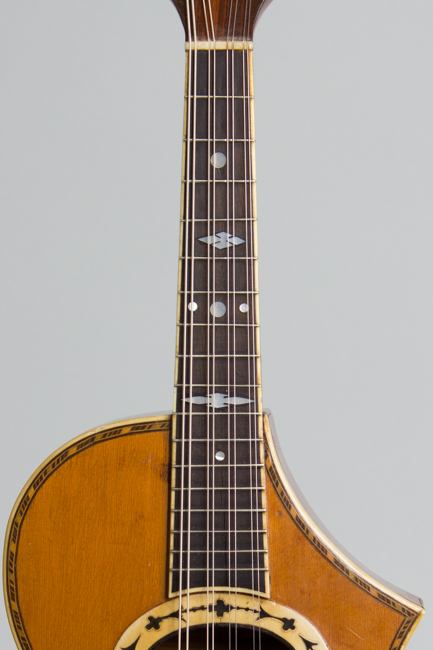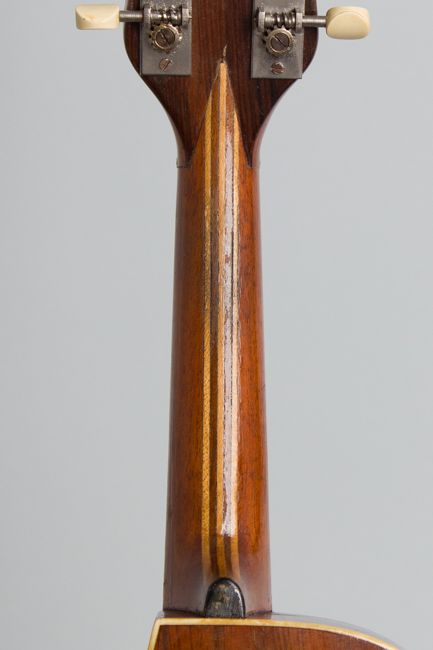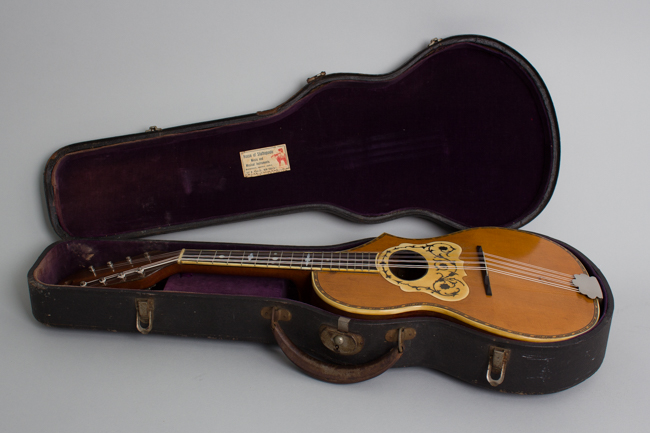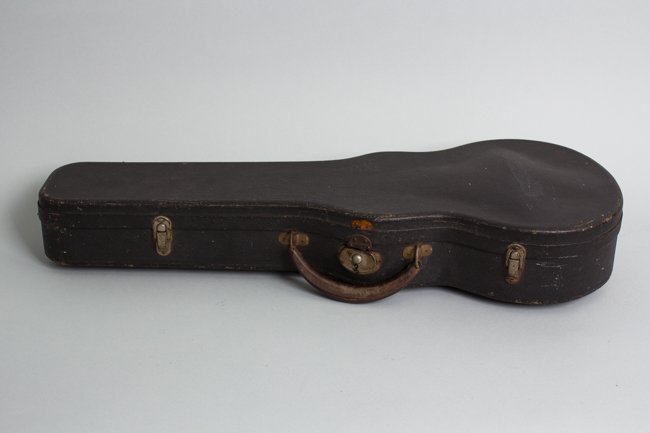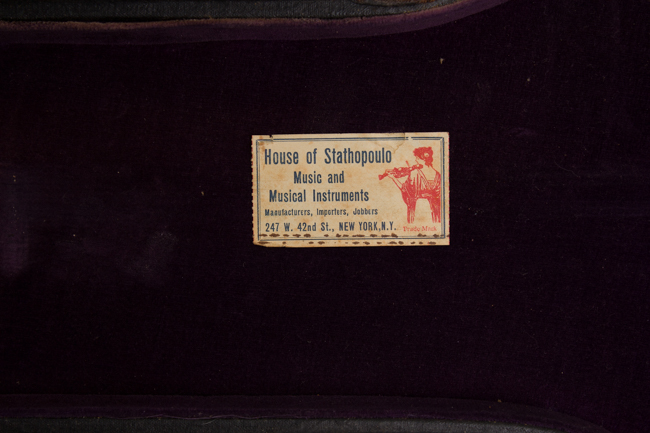Anastasios Stathopoulo Perfectone Model 25 A.8. Arch Top Mandolin (1913)
This item has been sold.
Item # 12168
Prices subject to change without notice.
Anastasios Stathopoulo Perfectone Model 25 A.8. Model Arch Top Mandolin (1913), made in New York City, serial # 5386, natural varnish finish, walnut back and sides, spruce top; laminated mahogany and maple neck with ebonized fingerboard, original black hard shell case.
The name Anastasios Stathopoulo is not particularly well-known, but his legacy in American fretted instruments is historically rather important. Anastasios was "the Father of Epiphone" (literally) as that company was the outgrowth of his "House of Stathopoulo" operation perpetuated by his sons. He originally brought his family to New York in 1903 from Smyrna, escaping the persecution of Greek nationals in Turkish territory. He was already an experienced instrument maker, and practically the entire family became involved in the business.
Like many other immigrants at the time the Stathopoulos arrived through Ellis Island and never moved beyond New York City, a well-established center of fretted instrument manufacturing at the time. Just in lower Manhattan there were a number of (mostly Italian) shops including Raphael Ciani, Cerrito, Yosco, the Favilla brothers, and many others. The city was also home to large retail/wholesale jobbers such as Ditson, Buegeleisen & Jacobson, and Bruno & Sons, who would often commission lines of instruments from local manufacturers. Across the East River in Brooklyn was the Gretsch operation; in the other direction over the Hudson was the giant Oscar Schmidt factory in Jersey City. When Anastasios set up shop he could have easily been lost in this bustling world, but could rely on a ready-made market in other recent immigrant Greeks who wanted the traditional instruments he was already experienced in building.
Although it relocated frequently in the early years the Stathopoulo business was apparently quite successful. Unusually for a recent immigrant working family eldest son Epaminondas (Epi) graduated from Columbia University. When Anastasios died suddenly in 1915, Epi took over and before long built the business up beyond his father's dreams.
Along the way Greek folk instruments were supplanted by the more widely popular mandolins, guitars and then banjos, which were the engines of the company's first glory days in the 1920s. As the sons joined the business the labels dropped Anastasios' initial and proclaimed their source as the "House of Stathopoulo". In the early 1920s the company's elaborate and expensive banjos began carrying a new name that would become a major force in 20th century instruments: Epiphone.
Original Anastasios Stathopoulo instruments are extremely rare; these hand built items they lacked mass exposure, likely only sold locally in New York. Stathopoulo was a creative builder often favoring unconventional body and sound hole shapes on instruments ranging from mandolins to some spectacular harp guitars.
This very interesting mandolin is a perfect example, with a unique body shape and many unusual design touches. The lopsided cutaway on the body is an amazingly futuristic design for the time, a Stathopoulo trademark used on guitars up through the Epiphone Recording models of the late 1920s. The spruce top is bent in the traditional spot but also has a slight arch, bound in ivoroid with fancy chain wood marquetry trim. The ivoroid pickguard is inlaid into the top with contrasting dark floral filigree.
The multiple laminations in the slim neck and the scarf joint at the base of the headstock are Stathopoulo trademarks. The bound ebonized fingerboard has mixed dot and shaped pearl inlay. The rosewood-faced headstock is crowned with a Vinaccia-style cutout. Under the soundhole is a fabulous intact A. Stathopoulo "Perfectone" (Trade Mark) label with the serial number, style and date of the instrument (Dec. 1913) handwritten in. A small hot stamp oval on the top reads "A. Stathopoulo New York". The original hard case is intact as well, bearing a "House of Stathopoulo" label under the lid. The craftsmanship of this completely handmade piece is very good, equal or better than most New York made instruments of the day.
This is a lovely, striking and historically important instrument, the only one like it we have seen. Early pre-Epiphone instruments are all rare, but pieces directly attributable to Anastasios extremely so. This early mandolin using his family's unique cutaway body shape is a fascinating glimpse into the beginnings of one of the 20th century's great fretted brands. As a bonus, it is completely playable and sweet sounding in the bargain.
Overall length is 24 3/4 in. (62.9 cm.), 9 3/8 in. (23.8 cm.) wide at lower bout, and 2 in. (5.1 cm.) in depth at side, taken at the end block. Scale length is 13 1/2 in. (343 mm.). Width of nut is 1 1/16 in. (27 mm.).
While this instrument shows some wear and repair, for its age (111 years and counting) it remains well-preserved and eminently playable. Everything on the instrument appears original. There is general wear to much of the finish, with small dings and chips and some fairly minor pickwear to the top. The finish is worn through in spots on the back of the neck from play.
The instrument is quite solid and playable but shows a number of old repairs. The back has a large conspicuous crack running lengthwise through the center, repaired solidly but visibly with some finish polishing around it. The sides have a couple of repaired cracks as well but the top is crack free. The neck appears to have been off and back on, the angle is quite good. There is a patched strap button heel on the cutaway side below the heel.
What appear to be the original small frets (which are cut through the binding) have some noticeable wear but are still playable. While it is fully playable with a lovely if delicate sound we consider this primarily a historically important instrument, one of very few of this luthier's creations to survive original and intact. It is not only a lovely piece in itself but stands as a testament to the earliest immigrant roots of Epiphone, one of the 20th century's most important American fretted innovators. Very Good + Condition.
The name Anastasios Stathopoulo is not particularly well-known, but his legacy in American fretted instruments is historically rather important. Anastasios was "the Father of Epiphone" (literally) as that company was the outgrowth of his "House of Stathopoulo" operation perpetuated by his sons. He originally brought his family to New York in 1903 from Smyrna, escaping the persecution of Greek nationals in Turkish territory. He was already an experienced instrument maker, and practically the entire family became involved in the business.
Like many other immigrants at the time the Stathopoulos arrived through Ellis Island and never moved beyond New York City, a well-established center of fretted instrument manufacturing at the time. Just in lower Manhattan there were a number of (mostly Italian) shops including Raphael Ciani, Cerrito, Yosco, the Favilla brothers, and many others. The city was also home to large retail/wholesale jobbers such as Ditson, Buegeleisen & Jacobson, and Bruno & Sons, who would often commission lines of instruments from local manufacturers. Across the East River in Brooklyn was the Gretsch operation; in the other direction over the Hudson was the giant Oscar Schmidt factory in Jersey City. When Anastasios set up shop he could have easily been lost in this bustling world, but could rely on a ready-made market in other recent immigrant Greeks who wanted the traditional instruments he was already experienced in building.
Although it relocated frequently in the early years the Stathopoulo business was apparently quite successful. Unusually for a recent immigrant working family eldest son Epaminondas (Epi) graduated from Columbia University. When Anastasios died suddenly in 1915, Epi took over and before long built the business up beyond his father's dreams.
Along the way Greek folk instruments were supplanted by the more widely popular mandolins, guitars and then banjos, which were the engines of the company's first glory days in the 1920s. As the sons joined the business the labels dropped Anastasios' initial and proclaimed their source as the "House of Stathopoulo". In the early 1920s the company's elaborate and expensive banjos began carrying a new name that would become a major force in 20th century instruments: Epiphone.
Original Anastasios Stathopoulo instruments are extremely rare; these hand built items they lacked mass exposure, likely only sold locally in New York. Stathopoulo was a creative builder often favoring unconventional body and sound hole shapes on instruments ranging from mandolins to some spectacular harp guitars.
This very interesting mandolin is a perfect example, with a unique body shape and many unusual design touches. The lopsided cutaway on the body is an amazingly futuristic design for the time, a Stathopoulo trademark used on guitars up through the Epiphone Recording models of the late 1920s. The spruce top is bent in the traditional spot but also has a slight arch, bound in ivoroid with fancy chain wood marquetry trim. The ivoroid pickguard is inlaid into the top with contrasting dark floral filigree.
The multiple laminations in the slim neck and the scarf joint at the base of the headstock are Stathopoulo trademarks. The bound ebonized fingerboard has mixed dot and shaped pearl inlay. The rosewood-faced headstock is crowned with a Vinaccia-style cutout. Under the soundhole is a fabulous intact A. Stathopoulo "Perfectone" (Trade Mark) label with the serial number, style and date of the instrument (Dec. 1913) handwritten in. A small hot stamp oval on the top reads "A. Stathopoulo New York". The original hard case is intact as well, bearing a "House of Stathopoulo" label under the lid. The craftsmanship of this completely handmade piece is very good, equal or better than most New York made instruments of the day.
This is a lovely, striking and historically important instrument, the only one like it we have seen. Early pre-Epiphone instruments are all rare, but pieces directly attributable to Anastasios extremely so. This early mandolin using his family's unique cutaway body shape is a fascinating glimpse into the beginnings of one of the 20th century's great fretted brands. As a bonus, it is completely playable and sweet sounding in the bargain.
Overall length is 24 3/4 in. (62.9 cm.), 9 3/8 in. (23.8 cm.) wide at lower bout, and 2 in. (5.1 cm.) in depth at side, taken at the end block. Scale length is 13 1/2 in. (343 mm.). Width of nut is 1 1/16 in. (27 mm.).
While this instrument shows some wear and repair, for its age (111 years and counting) it remains well-preserved and eminently playable. Everything on the instrument appears original. There is general wear to much of the finish, with small dings and chips and some fairly minor pickwear to the top. The finish is worn through in spots on the back of the neck from play.
The instrument is quite solid and playable but shows a number of old repairs. The back has a large conspicuous crack running lengthwise through the center, repaired solidly but visibly with some finish polishing around it. The sides have a couple of repaired cracks as well but the top is crack free. The neck appears to have been off and back on, the angle is quite good. There is a patched strap button heel on the cutaway side below the heel.
What appear to be the original small frets (which are cut through the binding) have some noticeable wear but are still playable. While it is fully playable with a lovely if delicate sound we consider this primarily a historically important instrument, one of very few of this luthier's creations to survive original and intact. It is not only a lovely piece in itself but stands as a testament to the earliest immigrant roots of Epiphone, one of the 20th century's most important American fretted innovators. Very Good + Condition.
